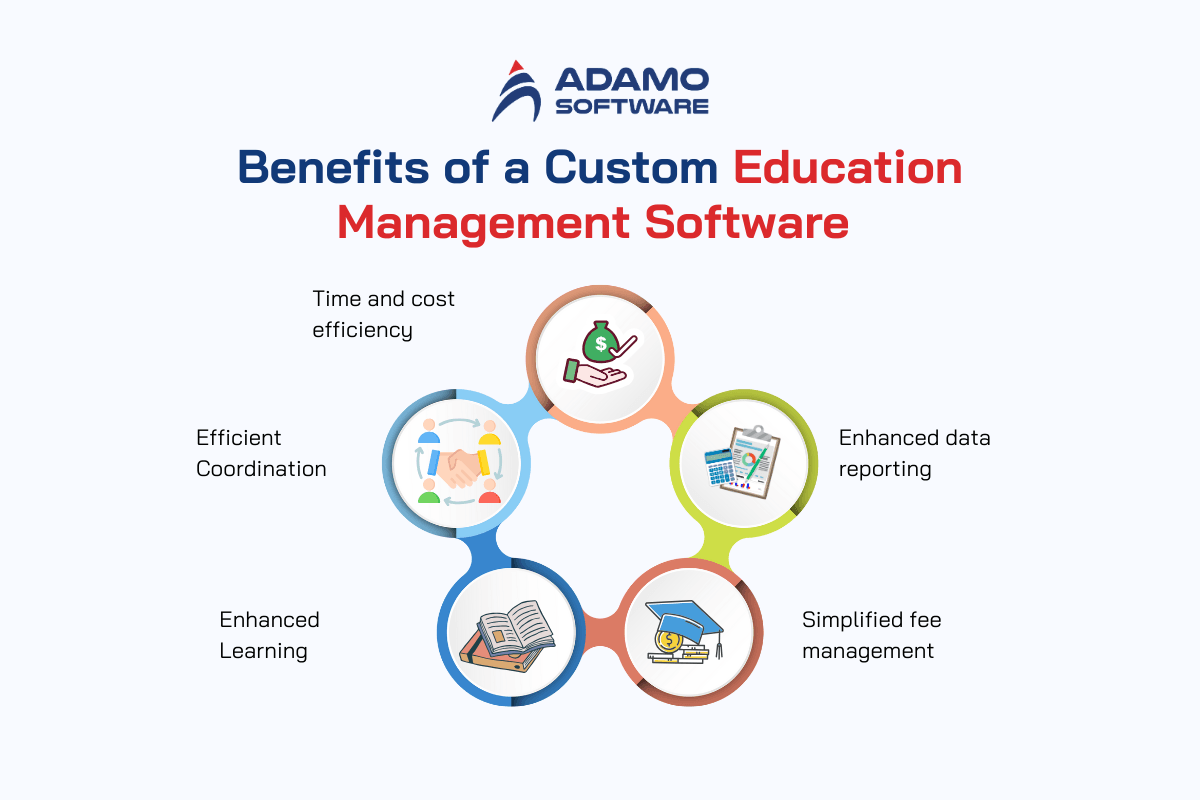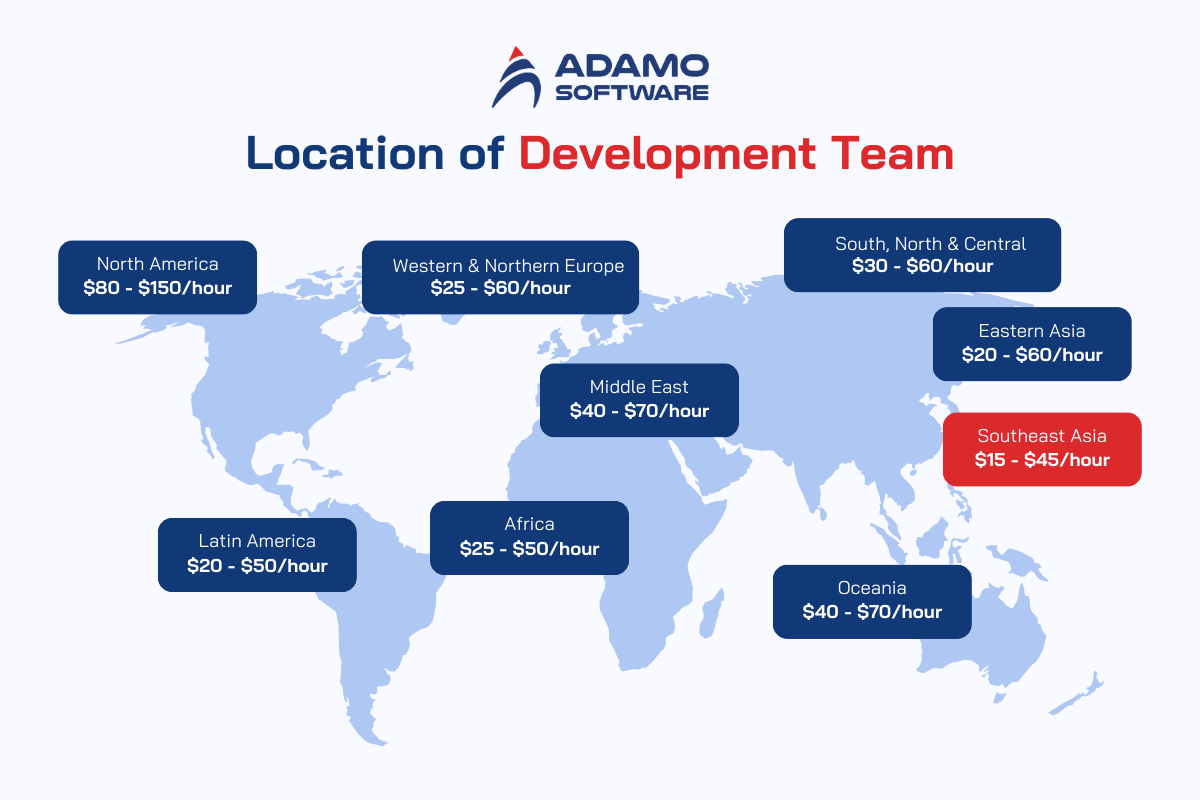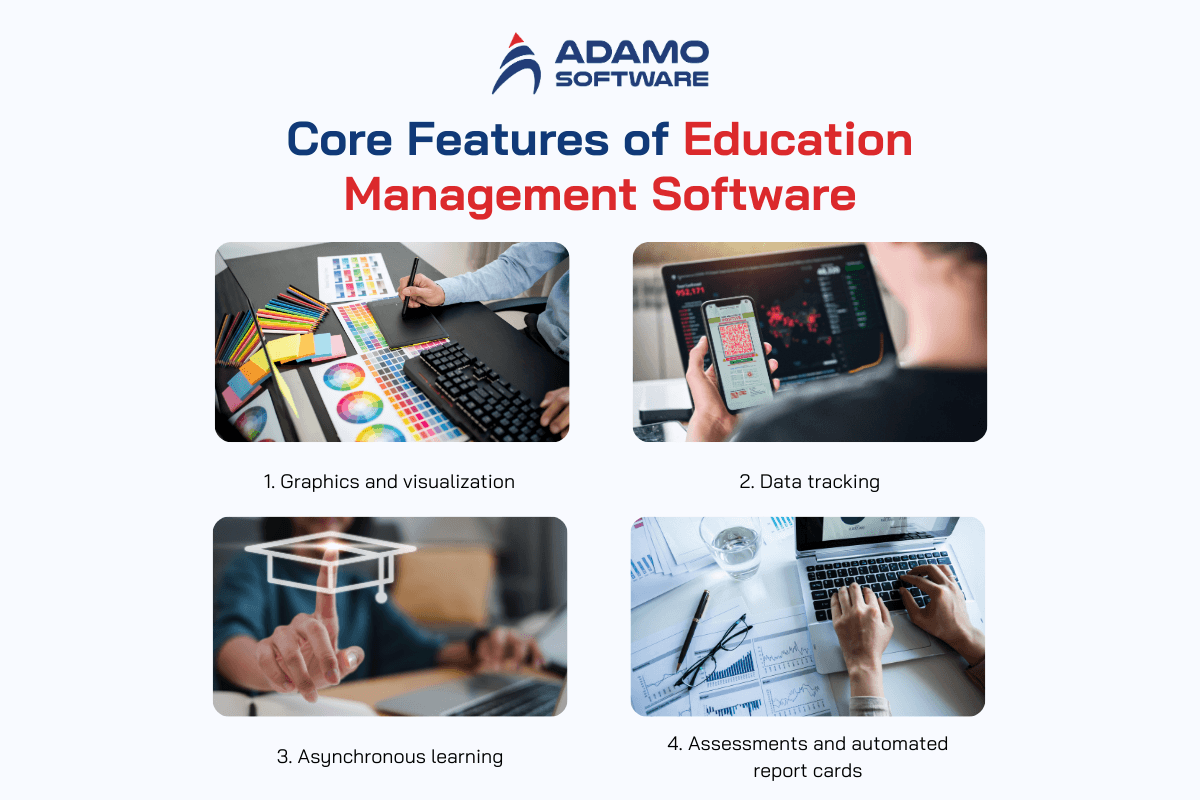How Much Does It Cost to Develop Education Management Software

The learning environment today is rapidly evolving through technology as institutions strive to improve their operations. Leading this movement is education management software (EMS).
EMS manages all the administrative processes, aids in communication, and enhances organization in schools, universities, and training institutions. But with such a powerful tool comes the question: how much does it cost to develop an EMS?
This article will go into the details of EMS and its essence and advantages. We will review the different factors affecting the cost of development and provide an estimation for your reference. Let’s dive in!
I. What is Education Management Software
Education management software can be described as a centralized online tool that helps facilitate and enhance administrative tasks in education. It’s like a hub of information that is gathered, analyzed, archived, and distributed about students, faculty, employees, and the organization. This software scans all the functions ranging from enrollment, attendance, grading system, timetable, fee payment, and many more.
It simplifies routine operations and makes information on-the-go, and therefore, education management software increases the efficiency of educational institutions. It can help administrators to make good decisions while teachers can spend time teaching the students. Also, students receive access to materials, an individual approach to training and communication with teachers and classmates.
The increasing popularity of online services among students makes education management software an integral part of the modern educational process. It enables schools to build a smarter learning environment for teaching and administration within the school.
II. Core Features of Education Management Software
1. Graphics and visualization
Information visualization is one of the most effective methods of comprehending large amounts of data. It has been proved that people are more likely to trust data or facts when they are illustrated graphically. Ideally, education management software should perform well in the aspects of data acquisition, storage and analysis. Thus, these systems can be helpful for educators and administrators. They can turn the amassed data into comprehensible and easy to understand graphical images.
2. Data tracking
Education management software can improve the processes associated with the student life cycle ranging from admission to graduation. These systems improve efficiency and clarity when all student information, like attendance, course work, and assessment. The integration of real-time access to data helps the administrators, teachers, and parents to be informed and make informed decisions.
3. Asynchronous learning
Among all the advantages of education management software, flexibility in learning is one of them. The mentioned platforms facilitate asynchronous learning because students get access to recorded lectures, additional materials, and activities. Students can study whenever they want while teachers can also dedicate their time to individual attention to each learner.
4. Assessments and automated report cards
Assessment and reporting in education management software is easy. Computer assisted grading and progress tracking relieve teacher’s workload and help students get results immediately. Reporting tools like grade point average and performance reports help track students’ achievement and instructional needs.
Also read: Top Essential Features of Education Consultancy Software
III. Benefits of a Custom Education Management Software
Education management software offers a range of advantages for students, parents, and school administrators. Let’s explore some key benefits:

1. Time and cost efficiency
Education management software can prove highly effective in terms of cutting down on administrative tasks. With features like scheduling classes, checking attendance and even communication with parents, the teachers will be able to teach more. Administrative modules on financial management can facilitate tasks such as payment of employees’ salaries and fees for schools.
2. Enhanced data reporting
Another advantage of education management software is that it has highly developed reporting features. The formats of reports that the administrators can make consist of graphical, summary and detailed reports. This information can be applied in determining the performance of students, marking attendance among other things.
3. Simplified fee management
Education management software can help parents with fee payment while helping schools organize the same. The online payment of fees will also help parents avoid long queues when paying the fees of their children. Schools are offered dependable online payments methods, and the institution can better manage the fees.
4. Efficient Coordination
The management of education also requires software that ensures the effectiveness of communication and events. It also helps in disseminating information about meetings and school activities, assignments among the teachers, students, staff, and parents.
5. Enhanced Learning
EMS often includes teaching aids in the form of learning modules that are interactive and suit all students. These modules allow students to understand concepts visually and at their own convenience. Such systems provide interesting learning experiences in a school. Therefore, it contributes immensely towards achievement of the fundamental mission of an educational institution, which is to educate people.
IV. Off-the-shelf vs Custom Education Management Software
1. Off-the-shelf education management software
An off-the-shelf education management software is a ready-made solution that is intended for educational processes conducted online. It can be bought from other organizations or received through a license. Sometimes it is called ready-made or out-of-the-box education management software. It has basic functions such as course creation, content, users tracking, and performance reports.
Off-the-shelf education management software offers several advantages:
- Cost-effective: Generally offered at a lower cost compared to solutions developed specifically for the application, since solutions are used more widely.
- Rapid deployment: Pre-built nature involves less configuration, and this makes the implementation faster and can get to the market faster.
- Industry best practices: Adapts best practices from the industry as well as the features backed by research.
- Comprehensive support: Has vendor support, user communities, and online resources that can be utilized by the user.
- Regular updates: Helps to keep the software up to date with the new technologies as well as the needs of the users.
- Ideal for testing: It will be suitable for organizations which have not applied online learning to evaluate the impacts.
2. Custom education management software
A custom EMS is an online tool developed uniquely for an organization based on its teaching and learning requirements. Some of the features include course management, content development, learning progress, assessment, and collaborative tools.
Custom education management software provides several key advantages:
- Customization: In line with the organization objectives and the branding strategy, it provides an individualized approach to learning.
- Flexibility: Facilitates content differentiation, the formative and summative assessments, and the delivery mode in accordance with various training needs.
- Scalability: Can adapt to the new requirements of the organization and new users.
- Improved ROI: Achieves increased value for money, better efficiency, and staff motivation.
- Integration: Integrates with other systems so that no matter where information is coming from or going to it is consistent.
- Advanced analytics: Gives elaborate analysis that can be of much help in decision making and performance evaluation.
- Enhanced security: Safeguards training data since they contain information that may be sensitive, as well as compliance to the industry standards.
Below is an image that compares off-the-self and custom education management software

V. Factors Affect Education Management Software Cost
Building an education management software from scratch involves various factors affecting its price. Let’s explore some factors impacting the cost of an educational management system.
1. Features and functionalities
The degree of complexity of an EMS system determines the amount of time and effort that goes into its creation. This overview outlines key features that contribute to the overall project cost:
- Content creation and management: Resources and platforms that allow instructors to create engaging lessons, quizzes and to monitor learners’ performance.
- Evaluation and feedback: Quizzes, tests, and surveys generation and grading tools, feedback and reporting tools.
- Online interactions: Tools for teaching live classes and tools students use to complete group projects such as Screen Share and Google Meet.
- Student engagement: Features for communication and collaboration within students through posts and other social elements connected with teamwork.
- Accessibility: Responsive design for desktop and mobile, mobile application design, offline first design.
- Interactive learning: Gamification features to include incentives, rivalry, and tasks to increase the interest of the audience.
- Data analysis: Assessment, monitoring the student’s academic performance, and finding out areas that need enhancement with data analysis and dashboards.
- Customization: The options to change the interface of the software according to the branding and the specific needs.
- Security: Security measures to ensure that the data is protected, and the privacy laws are met for user identification and encryption.
2. Technology stack
In terms of the expenses of a software project, the technology stack plays a major role. Using state-of-the-art tools can increase the development costs, yet it usually results in better scalability, flexibility, and user experience. However, choosing old technologies may initially lower the costs at the expense of the software’s performance and vulnerability.
In order to predict future expenditures, it is necessary to focus on the main technological factors:
- Programming languages: Such languages as Python are more sophisticated requiring the services of highly skilled developers, hence the high cost of labor.
- Frameworks and libraries: Using such tools can help in early completion of projects and also cut down on costs. However, complex solutions require developers with some level of experience in programming.
- Hosting and infrastructure: Many processes can be managed on the cloud instead of using expensive infrastructure, like Amazon Web Services and Microsoft Azure.
- Development tools and platforms: Software development tools such as IDE, SCM, and project management tools help to organize processes and minimize expenses.
- Mobile compatibility: The utilization of software for mobile devices incorporates extra technological elements like responsive design and mobile application development platforms.
- Scalability and performance: Due to increasing numbers of users and courses, load balancers are required or caching servers can be used. These technologies also affect the cost element of the project.
3. Integration with other systems
Connecting an EMS to other applications requires more work, which affects the project’s cost. Key factors influencing these expenses include:
- Number of systems: Implementing one system is already complex and adding another system to it makes the project even more complex. Thus, it takes more time and money to develop.
- API availability: Applications that are not well documented take time to develop and eventually raise the cost of the EMS. Integrations where customization is also necessary entail the use of more resources, and thus the cost is usually high.
- Data mapping and migration: Copying a big amount of data takes more time and increases the cost of a project.
- Testing and validation: The proper testing of the integrations is an important necessity to guarantee the data coherence and stability of the systems. Hiring professionals for validation also increases the costs of the project.
- Maintenance and support: The continued maintenance of such systems and the provision of technical support require more resources. Therefore, the costs are higher in the long run.
4. UI/UX Design
Introducing a good UI/UX design helps in enhancing user experience hence making the system to be easily and efficiently used. Nevertheless, the design phase determines the overall development cost of an education management software significantly. Key factors contributing to this include:
- UI design complexity: The use of custom graphics, animations, or any other complex features requires extra capital investment.
- UX design: Designing an excellent and user-friendly UX design, especially if multimedia components are involved, requires effort and planning.
- Mobile responsiveness: Most software must work on different screen sizes and resolutions, and this makes the development process more difficult and expensive.
- Accessibility: EMS that is easy for users with disabilities, entails profound design and development requirements, which influence the cost factors.
5. Development team
The rate of developers is dependent on their geographical location, experience, and the overall team size. Several factors influence these expenses:
- Team size: Large teams which can coordinate the different aspects of a project can greatly help in speeding up the development process. But this large workforce brings about the problem of the high cost of labor.
- Location: Location affects this due to the living costs, average wages, taxes, and demand for specialized skills in a certain location.
- Skill level: Mid – level and senior developers come up with better solutions than junior developers, and they earn higher salaries.

VI. Estimated Cost to Build Custom Education Management Software
Before creating your own education management software, you need to analyze the numerous types of software solutions currently out there. The following outlines three primary categories of EMS, accompanied by approximate pricing estimates. They include custom, off-the-shelf, and SaaS-based EMS.
1. Custom education management software
Custom EMS entails the creation of a tailored system from scratch, aligned with your institution’s specific requirements. This approach undeniably demands a more substantial investment of time and resources. Therefore, its development costs typically range from a substantial $75,000 to well over $500,000. The ultimate expenditure can fluctuate depending on the project’s scope, the desired functionalities, and your institution’s specifications.
2. Off-the-shelf education management software
The use of off-the-shelf EMS comes with the need to purchase licenses and make further payment for subscription services. They can include per user or per seat cost or a tiered model. So, the cost can vary based on the features, the number of users or the size of an organization. Like any product that is designed to be used by multiple users, predicting the costs of an off-the-shelf solution can be somewhat difficult. This is because of the licensing costs, and the other factors that dictate scalability.
In most cases, the costs range between $15,000 to $100,000. Off-the-shelf software is cheaper to acquire initially than the custom developed ones. However, accompanying resource provisions for installation, staff training and data conversion may be required. Also, operating costs are known to expand due to recurrent costs involved in the constant maintenance of the machinery.
3. SaaS-based education management software
SaaS-based EMS is a cloud solution that enables educational organizations to manage, deliver, and develop online learning and training courses. These systems are available and managed through web browsers or applications. The software provider is in charge of hosting and managing the program.
Almost all educational management software that are SaaS-based often contain the ability to multi-tenant. That is, multiple educational institutions can use the same copy of the software at the same time. But the data will be secure and allow for personalization. The annual expenses for SaaS-based EMS range from $2000 to $ 10000 for small and medium institutions. Large institutions with complex operations might have to pay up to between $50000 to $ 200000.
VII. Consider Adamo Software as a Trusted Partner for Education Management Software Development
Are you an educational institution that has faced such challenges as inefficiency and seeking to build an EMS? Adamo Software can be your ideal partner.

With a proven track record in education software development, we offer tailored solutions to meet your specific needs. Our team of skilled developers combines deep industry knowledge with cutting-edge technology to deliver exceptional results.
Ready to transform your educational processes? Contact us today and let’s achieve your goals.












